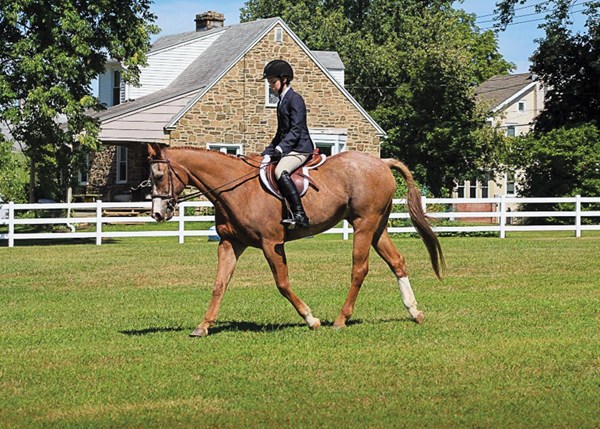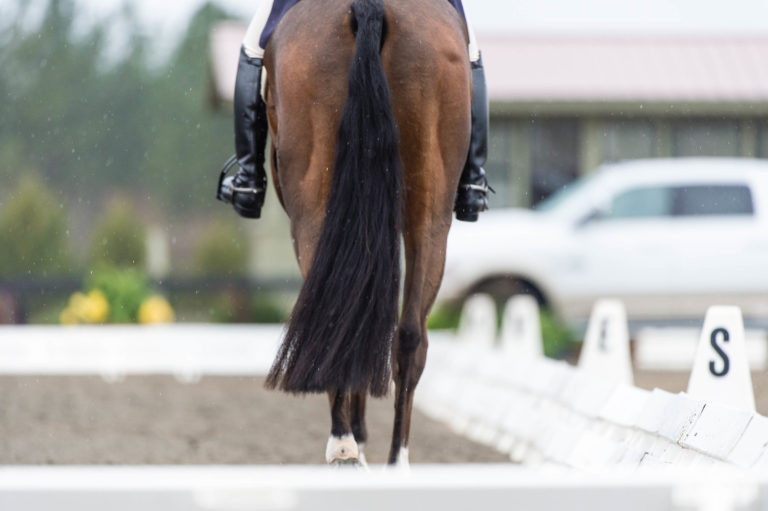
This picture shows 15-year-old Molly Granahan riding her leased 23-year-old Welsh–Thoroughbred-cross gelding, Rain, at a hunter show. Although they have competed at hunter shows, Molly is now mainly practicing dressage, working on Training Level tests.
Looking at Rain, I would not have guessed his age. I have great respect for old horses as they can teach and give riders so much. He, too, looks like a real gentleman whom his rider can trust.
In terms of his conformation, Rain does have a lovely neck and carries it with good self-carriage and very light contact. With his good neck, he compensates for a weakness behind, as you will notice that he is built higher in the croup and has long, straight hind legs. This will make it harder for him to angle his haunches, lower his croup and step under his rider’s weight. In this picture, his hind leg is stepping a bit shorter than his front leg. The angle of the picture also adds to this impression. When taking pictures from the side, always make sure it is not at an angle and that the track the horse is working on is parallel to the frame of the picture.
Molly is riding in a jumping saddle and her seat provides a nice balanced base. My first impression is that she is balanced, relaxed and rides with feel. However, wanting to feel the horse and concentrating on his movement can lead to the habit of looking down, which disturbs your balance as a rider. It also slows down the automatic balance reactions in your core, which are so important for correct riding.
To shift your visual focus, try this: Focus on looking at a point in the distance, then glance down at your hands for a moment and try to focus on the same point you looked at before. You will notice that your eyes need a moment until they can clearly focus on that point again. Now sit straight, look with your eyes to the right and then turn your head to the right. This is considerably easier. Now look with your eyes again to the right but turn your head to the left. You will feel that this is a bit weird and requires more concentration. Automatically your body wants to move to where you look, and this is why in riding, the concept of looking where you ride is so important. Looking down encourages you to ride more downhill as well, and especially for a horse who might find it more challenging to move uphill, this is important to understand and correct. Looking straight ahead will give the rider automatic access to the correct muscles of her body to ride straight ahead, too.
In jumping, the horse should look at the fence. When he locks onto it, it feels like horse and rider get pulled into the right distance and approach. Dressage is more abstract. The horse does not always see such a clear line of travel. To understand this, I find the following image very helpful: Imagine that your eyes have a thin thread, like a cobweb, that connects you to where you are looking. Then the horse can find better balance with a more secure feeling in this connection between your eyes and the direction you choose to ride. When you glance down at your hands, even if only for a split second, this imaginary thread is cut and the horse also loses a sense of direction. This is also why it is very important to learn to shorten your reins and change the hand your whip is in without needing to look at your hands. Like typing blind on a computer keyboard, the rider must learn to handle her reins without the need of eye control.
Because I have the impression that Molly wants to ride with a lot of feel and lightness, I am pointing this out to her. It will help her to carry her hands and ride with more self-confidence and self-carriage in her own core, creating a positive tension that allows her to improve her feel. I wish her success in her future riding.











